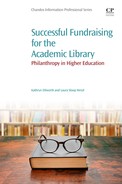Cases
Faculty positions
Abstract
Faculty positions are as important to the academic library in higher education as they are to any other department or unit across campus. Not only are faculty positions an avenue for lifelong funding, but the position itself becomes more prestigious through the naming. It highlights the gift of the donor and also increases the value of the position to the faculty member holding the position and thus affects any future recruitment for that position. As it also signifies an important area of research, a faculty position is a good case to take to a donor or prospective donor who is interested in research on a particular topic or specialized area of study.
Keywords
Endowment; Academic donors; Faculty chair; Proposal; Research; Higher education
Traditionally in higher education the named faculty chair was the most celebrated gift to a university (Thelin and Trollinger, 2014, p. 14). That seems to remain so within the university environment and for donors with a long philanthropic tradition in higher education. This case for giving may be less intuitive for those who are new to higher education philanthropy, but it can be positioned to interest donors if messaged properly.
Named faculty chairs are created through endowments. Because few scholarship opportunities make sense in the academic library (to be discussed in another chapter), these philanthropic gifts are an excellent option for donors who like the endowment structure. Thelin and Trollinger (2014) call endowments “…the hallmark and lifeblood of colleges and universities in the United States” (p. 95). Because of the status they have among higher education donors, this is a strong case for giving with alumni and friends who are interested in investing in the long-term success of the university.
There is no consistent fundraising structure for faculty chairs in higher education. We have even observed different structures between campuses in the same university system. In any structure, however, there are usually several ranks of faculty associated with different levels of giving. For example, a named professorship may require a $2M gift while an assistant professorship can be named for $1M. Another scenario emerging of late is the “rising star” opportunity which actually costs much less (say around $500K in some institutions), but expires after 5 years as opposed to a faculty chair that is named in perpetuity, utilizing the endowment to pay for the position. In the “rising star” scenario the funds are not held in an endowment. Rather, they are distributed over the course of the position and are more appropriate for a highly publicized visiting scholar or a professor completing work on a short-term, but groundbreaking, research project.
Donors interested in this type of gift often see themselves as investors. In the case of a named faculty chair, they are investing in the area of expertise, ensuring it will be around for years to come. This is a good case for giving for someone who has a specific interest or history in an area of research or has taught in it. The “rising star” is also an investment, but in an outcome, rather than the perpetuation of the position. The outcome can be the result of research or simply having a particular expert on campus for a specified period of time.
Not all academic libraries have faculty who are teaching and researching like the faculty in the other colleges. There are hybrid faculty positions where professors research but don't teach; in other cases there is no faculty structure at all for the academic library staff. Whatever the scenario, there are opportunities to have strategic positions named through a philanthropic gift that funds the position through an endowment. Depending on funding opportunities and the capacity of prospects, faculty chairs can be named at an amount that covers a portion of the cost for a faculty position, while the academic library covers the rest. At an even higher level, an endowment could pay for a faculty position as well as an assistant and possibly even a stipend for travel related to conference presentations and research. With the typical payout for an endowment at 5% per year, it's simple to calculate the funding required to generate the income needed each year for the position.
Providing the funds to endow a faculty position is not just about a donor attaching his or her name to something. When discussing the opportunity of an endowed chair, it is important to help the prospective donor understand what it means to faculty and what opportunity it provides for the academic library or any college or department as it relates to important research and prestige for the university and the academic library community.
In the academic world, a named position or, even better, a named faculty chair, is very prestigious. When working with prospects for faculty support, it is important to help them understand that one of the most valuable elements of the gift is that it will attract the best of the best to their university. Not all academic libraries offer faculty opportunities or named positions, but there is a lot of potential to get and keep the highest quality academic professionals to your library through the creation of an endowed chair.
Below are a few examples of named faculty chairs in an academic library:
■ Chair of University Archives (or even one particular archive or collection)
■ Chair of a particular library or division (eg, Chair of the Engineering Library)
■ Chair for a particular initiative (eg, Chair of Information Literacy)
■ Chair of a broad topic area (eg, Chair of Humanities or Chair of Science)
